In today’s digital landscape, the importance of website traffic for businesses cannot be overstated.
A consistent flow of visitors not only enhances brand visibility but also contributes to increased conversions and revenue growth. However, a sudden drop in site traffic can create a sense of alarm and uncertainty, leaving you wondering what could have gone wrong.
Addressing such a situation effectively requires understanding the possible factors that might have led to the decline in traffic. Let’s consider five crucial reasons why your website gets fewer visitors, as well as actionable tips to avoid or resolve those issues.
Why Did My Site Traffic Drop? 5 Reasons To Check Out
Reason #1: Google algorithm updates
Google constantly strives to improve its search engine by refining the algorithms used to rank websites in search results. These algorithm updates aim to provide users with the most relevant and high-quality content based on their search queries.
Some updates focus on addressing specific issues, such as eliminating spammy websites or promoting mobile-friendly sites, while others may target broader aspects of the search experience.
When Google rolls out an algorithm update, it can significantly impact your site’s ranking and traffic. If your website aligns well with the update’s goals, you may see increased traffic as your site moves up in search results. Conversely, if your website doesn’t meet the new criteria, its ranking may drop, leading to a decrease in organic traffic.
For instance, Google’s Panda update targeted low-quality content, penalizing websites featuring thin, duplicate, or irrelevant content. Sites that failed to comply with these new standards saw a decline in their search rankings, affecting their traffic.
Tips to stay updated on Google algorithm changes
Staying informed about Google algorithm updates is essential for maintaining and improving your site’s search ranking and traffic. Here are a few essential tips to follow:
- Monitor industry news: Regularly read SEO blogs and forums, such as Search Engine Journal, Moz, or Search Engine Land, to stay informed about the latest algorithm updates and their potential impact on your site.
- Check your site’s performance: Keep an eye on your site’s analytics, especially after a known update, to track any changes in traffic or search ranking. This will allow you to identify issues and make the necessary adjustments quickly. There are two ways to do this: opt for an SEO audit service or do it yourself.
- Join online communities: Participate in SEO-related communities or groups on social media platforms like Facebook, LinkedIn, or Reddit, where you can stay updated on the latest news, share experiences, and seek advice from fellow webmasters.
- Adopt best practices: Follow Google’s Webmaster Guidelines and prioritize creating high-quality, user-focused content. Thanks to this, future algorithm updates will have less of a negative impact.
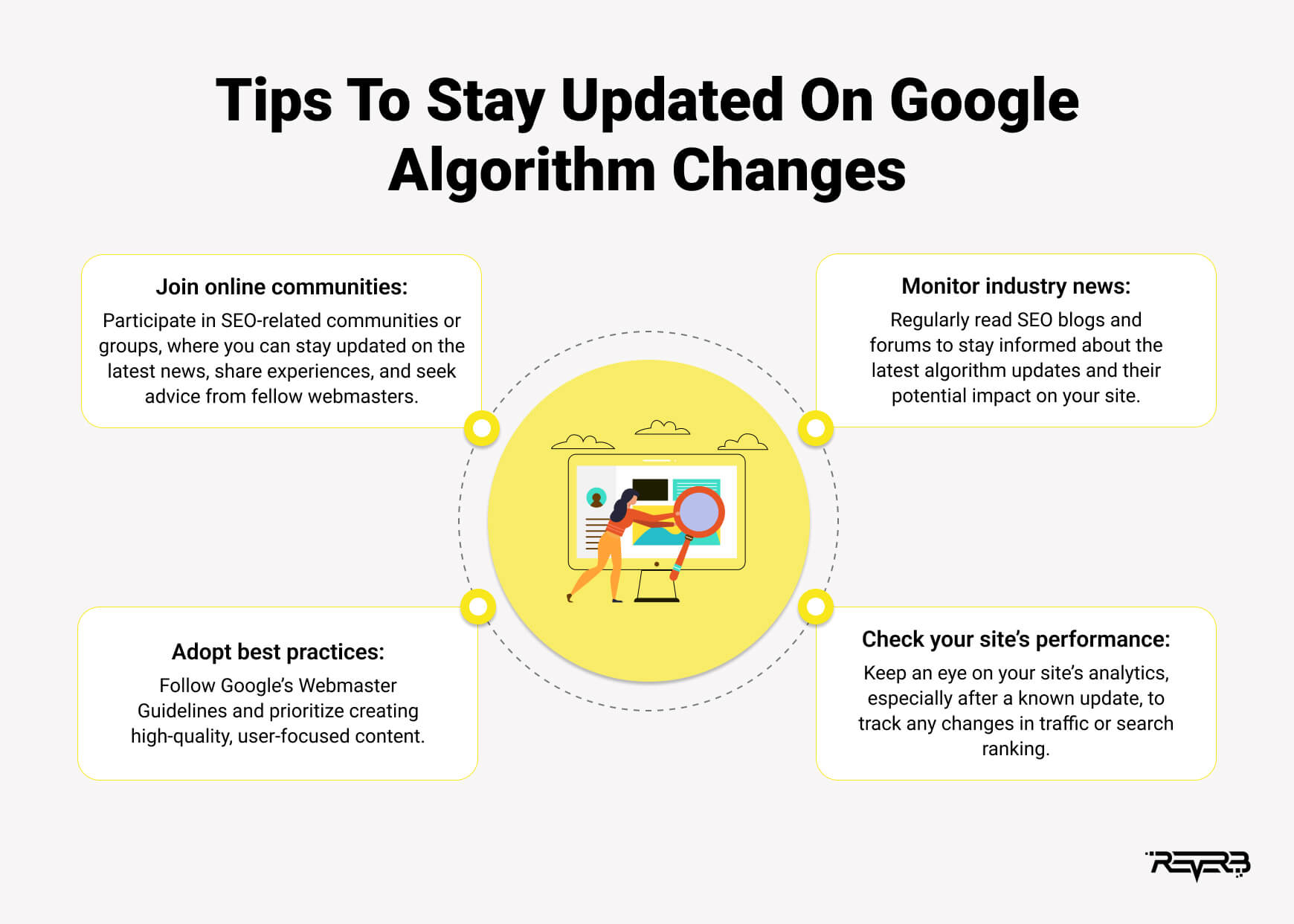
By staying informed and adapting your site to align with Google’s goals, you can maintain a solid online presence and ensure that your website traffic remains stable despite any changes in the algorithm.
Reason # 2: Tracking errors
Tracking errors can lead to inaccurate or incomplete data in Google Analytics, making it appear as though your site traffic has dropped when, in reality, the issue lies with the tracking code. If there are problems with the tracking code, Google Analytics may stop recording visits altogether.
Several factors can contribute to tracking errors in Google Analytics:
- Incorrect implementation: The tracking code might be missing, incomplete, or incorrectly placed on your website.
- Code conflicts: Issues with other scripts or plugins on your site may interfere with the proper functioning of the Google Analytics tracking code.
- Updates or changes: Modifications to your website, such as updating the theme or switching to a different content management system (CMS), can inadvertently remove or alter the tracking code.
- Filtering or blocking: Overly aggressive filtering settings within Google Analytics or users employing ad blockers can prevent some or all visits from being recorded.
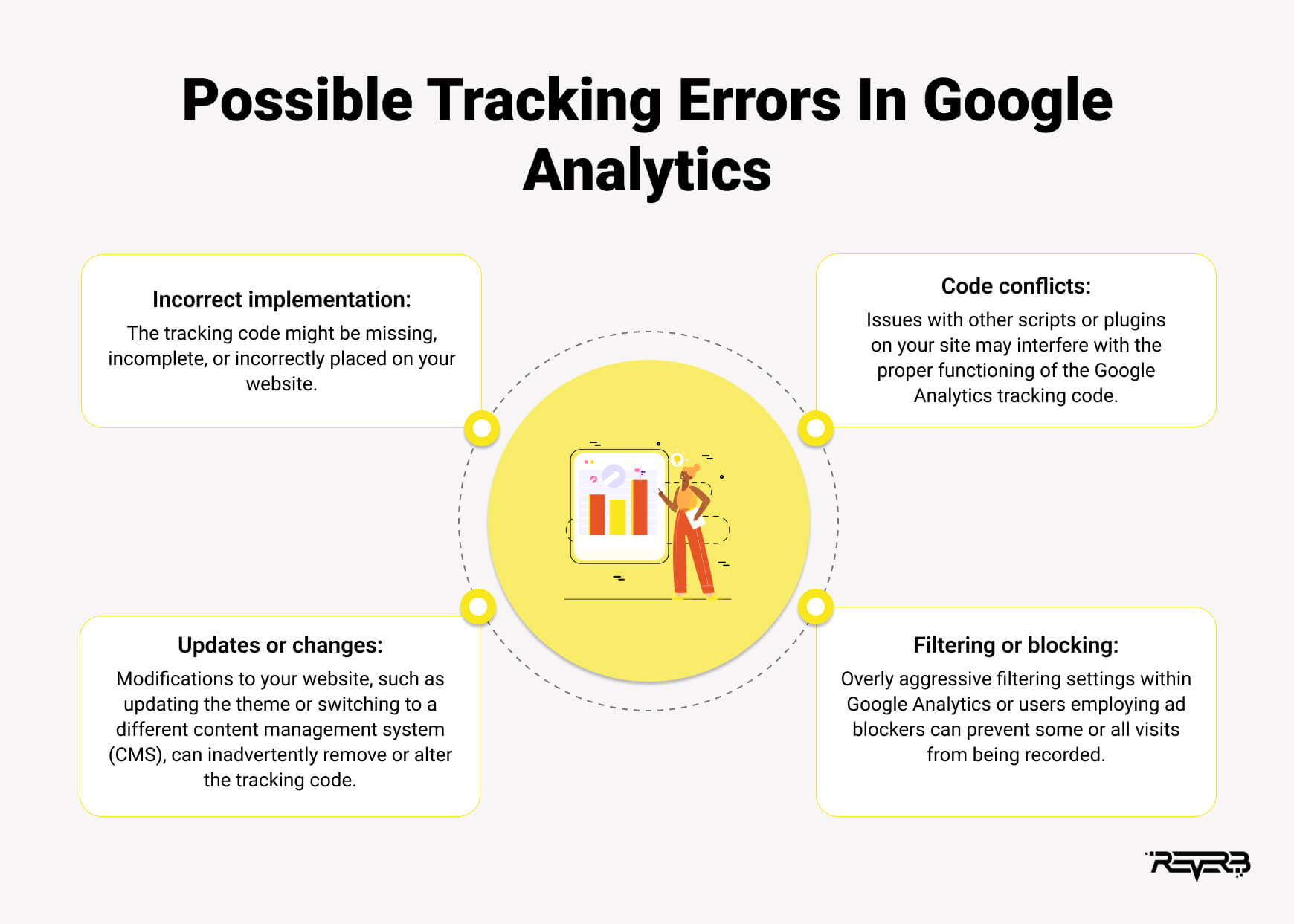
To identify and resolve tracking errors in Google Analytics, follow these steps:
- Verify the tracking code: Ensure that the Google Analytics tracking code is present on every page of your site. You can use tools like Google Tag Assistant or GA Checker to verify that the tracking code is correctly implemented.
- Inspect browser console: Open your website in a browser and access the browser’s developer console (usually by pressing F12). Look for any error messages related to the Google Analytics tracking code, which may indicate conflicts or issues with other scripts on your site.
- Review Google Analytics filters: Check the filters applied to your Google Analytics account to ensure they aren’t excluding valid traffic. For example, ensure you’re not inadvertently filtering out visits from specific IP addresses or geographic locations.
This issue might seem trivial, but it’s pretty common. So, it’s worth checking whether the tracking code works correctly.
Reason # 3: Negative SEO attacks
In highly competitive niches, some unethical competitors may use negative SEO attacks to hurt your website’s rankings and push it out of the top search engine results pages (SERPs). Negative SEO attacks can involve various tactics aimed at damaging your website’s reputation and search rankings, particularly:
- Spammy backlinks: An attacker may create a large number of low-quality, spammy backlinks pointing to your site. This can trigger Google’s Penguin algorithm, which penalizes sites with unnatural backlink profiles, resulting in lower rankings.
- Content scraping: Competitors may copy and republish your content on multiple websites, leading to duplicate content issues that can harm your rankings.
- Hacking: Attackers may hack into your website to inject malware, add spammy links, or modify your content, all of which can negatively impact your site’s reputation and search rankings.
- Fake reviews: Some competitors may post fake negative testimonials about your business on review sites or social media platforms, damaging your online reputation and potentially driving away potential customers.
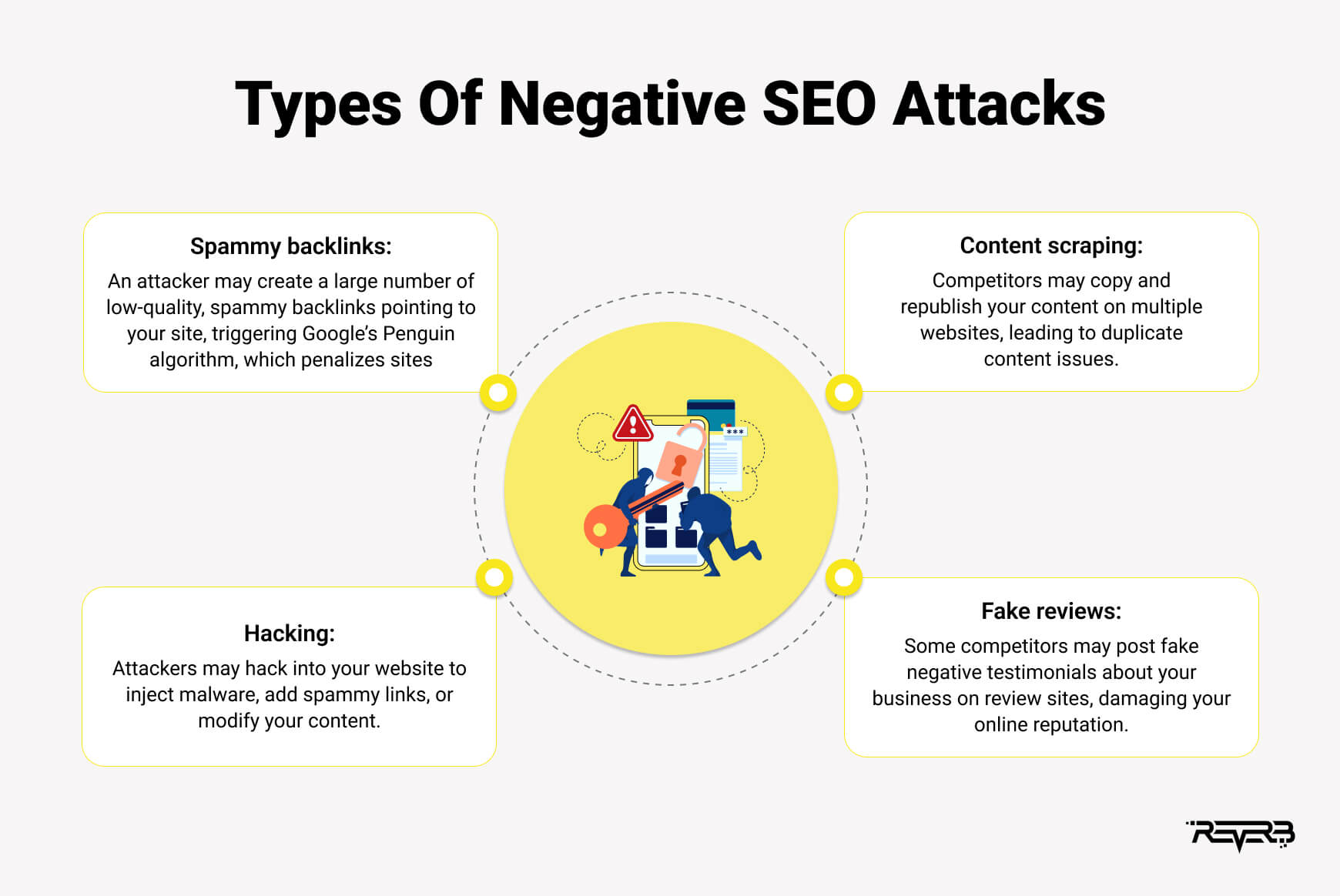
Identifying negative SEO attacks
To detect and combat negative SEO attacks, take the following steps:
- Monitor backlinks: Regularly check your backlink profile. Look for any sudden spikes in low-quality backlinks or links from irrelevant or spammy websites. Conduct some competitor backlink analysis to gain some potentially useful insights into how you can improve your backlink profile.
- Set up alerts: Use tools like Google Alerts or Ahrefs Alerts to monitor mentions of your brand and website. This can help you identify any instances of content scraping or fake reviews.
- Check website security: Ensure your website is secure and up-to-date to prevent hacking attempts. Regularly monitor your site for unauthorized changes, spammy content, or malware injections.
Take prompt action to address the issue if you believe a negative SEO attack has targeted your website. This may involve disavowing spammy backlinks, submitting a reconsideration request to Google, improving site security, or reporting fake reviews.
Reason #4: Technical issues
Technical problems are one of the most significant SEO factors that can significantly affect your website’s performance and user experience, decreasing site traffic and search rankings. In this section, we’ll delve into some common issues and their potential consequences.
- Slow page load time: Slow page load times can negatively impact your website’s user experience, search rankings, and conversion rates. Users are more likely to abandon slow-loading websites, while search engines like Google prioritize fast-loading sites in search results. You can use PageSpeed Insights or Search Console to measure the Core Web Vitals of your site and see if that’s why you’re losing traffic.
- Crawl errors: Crawl errors occur when search engines cannot access specific pages on your website, preventing them from being indexed and ranked in search results. Common crawl errors include server errors, blocked resources, and DNS resolution issues. Use Google Search Console to identify and fix crawl errors, ensuring that search engines can effectively crawl and index your website.
- Broken links and 404 errors: Broken links and 404 errors can harm your website’s user experience and search engine rankings. Users encountering broken links are more likely to leave your site, while search engines may view these errors as signs of poor site maintenance.
- Redirect errors: Redirect errors, such as improper 301 and 302 redirects or redirect loops, can confuse search engines and users alike. These errors can lead to a poor user experience and may prevent search engines from accurately indexing your site.
- Incorrect robots.txt rules: The robots.txt file is used to provide instructions to search engines on how to crawl your website. Incorrect rules in your robots.txt file can inadvertently block search engines from accessing important pages or resources, leading to reduced visibility in search results. Review your robots.txt file regularly and ensure it’s properly configured to allow search engines to access and index your site’s content.
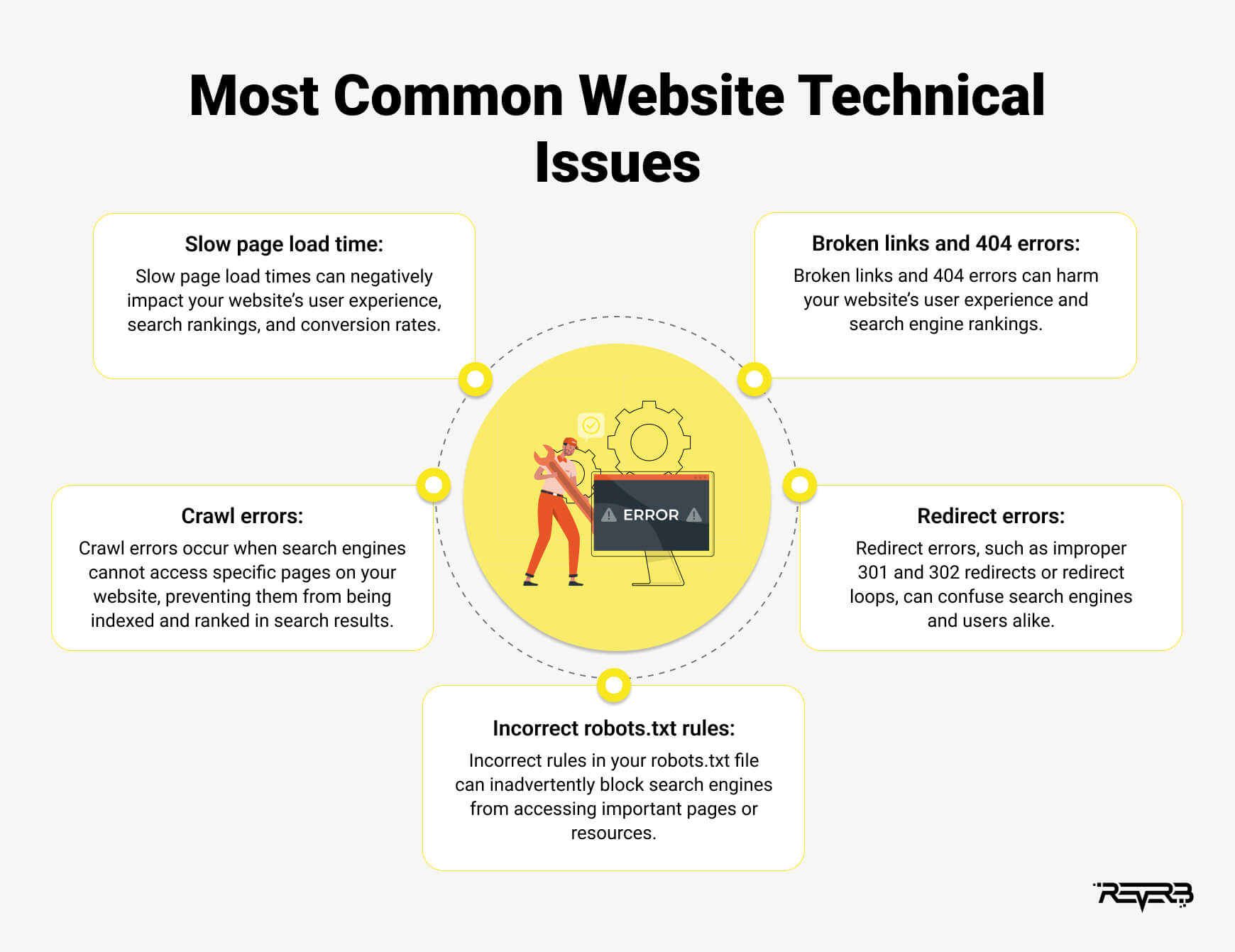
Reason #5: Lost backlinks
Backlinks are a vital factor in generating organic traffic and enhancing search engine rankings. Google sees these as “votes of confidence.”
A site with more high-quality backlinks will have greater Domain Authority and rank higher in search results, delivering more clicks. Therefore, if you lose some of your backlinks, anticipate that your rankings will decrease along with the traffic.
Reasons for losing backlinks
There are several widespread reasons why you might lose backlinks:
- Link removal: The website linking to you may have removed the link, either intentionally or accidentally, during site updates or redesigns.
- Website shutdown: The website providing the backlink may have shut down or gone offline, resulting in the loss of backlinks.
- Lost content: The linking page or content may have been deleted or moved to a different URL, causing the backlink to break.
- Algorithm updates: Search engine algorithm updates may devalue certain types of backlinks, leading to a perceived loss of backlinks when analyzing your backlink profile.
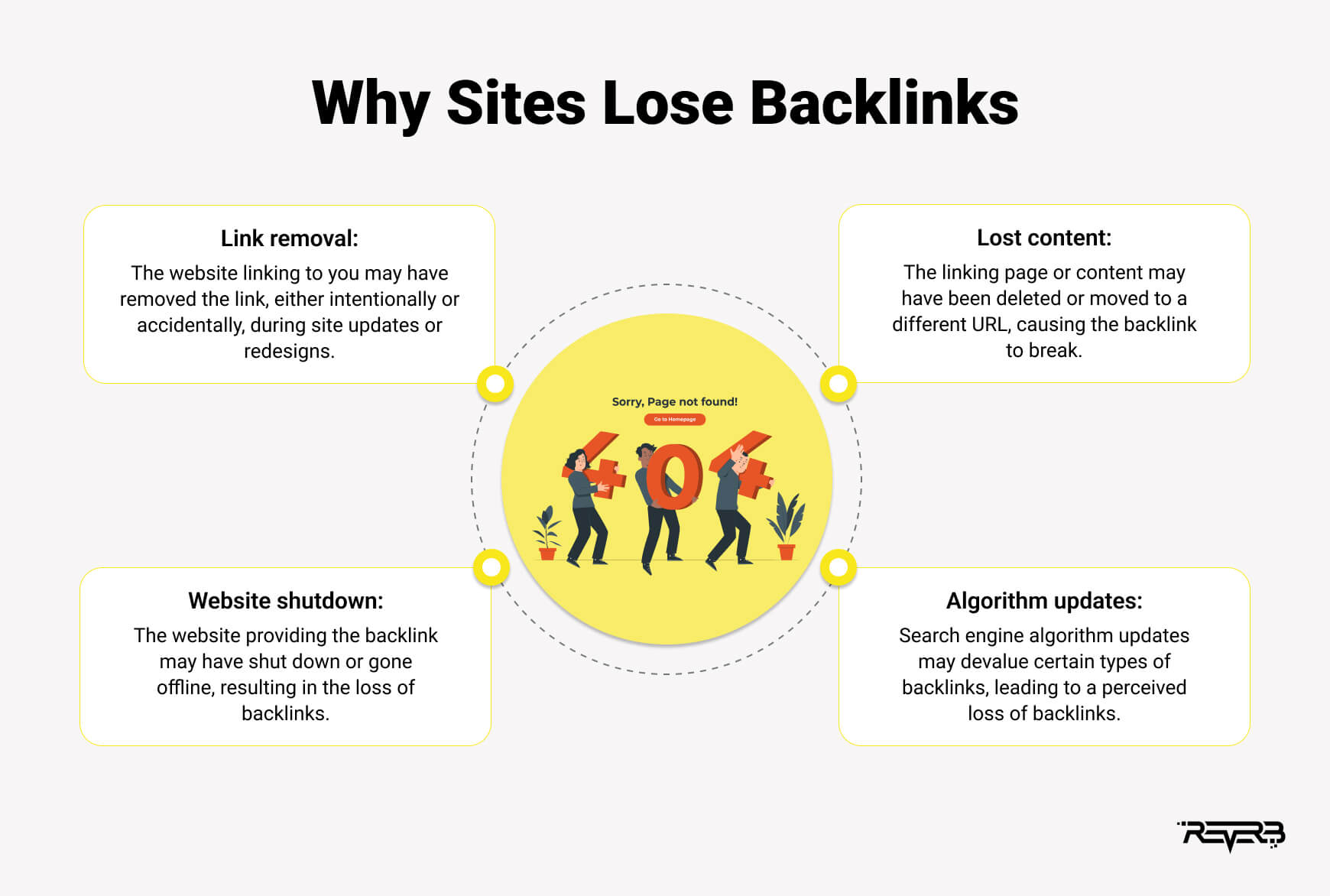
Most popular SEO software tools allow you to track your lost backlinks, showing which links and from which websites were removed. It’s recommended that you regularly investigate your backlink profile to identify lost backlinks.
From there, reach out to the owners of those websites and negotiate to update, placing the link back where it was or adding a new link back to your website.
Conclusion
Now you know some of the most common reasons that could be the cause of a drop in traffic. Surely, there are more, like manual actions, seasonal fluctuations, and outdated SEO techniques. We focused on those that are either often overlooked or happen the most.
If you’re having trouble finding the reason, then it might be a good idea to reach out to specialists. ReVerb’s professional SEO team will help save lots of time and pain by conducting a comprehensive SEO audit and suggesting actionable recommendations on improving your website’s performance and boosting traffic. Contact us today for the ultimate SEO support!









